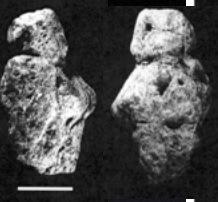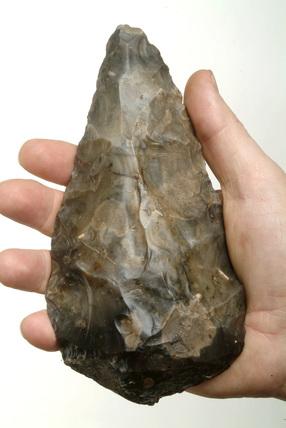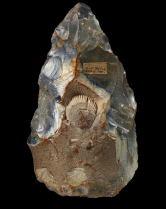
Some of the early Israeli beads
Arguably the earliest example of art produced by humans is a necklace made of shell beads, dating to around 100,000 years ago. These beads were found in Israel (Vanhaeren et al., 2006) and are over twice the age of the more famous European cave art! Although this is the most ancient piece of human art, many examples of imagery and art have been found that predate the emergence of our species. Art, it would seem, is not uniquely human.
The earliest of these pre-human examples of imagery is the Berekhat-Ram figurine, also recovered from Israel. It dates to between 200 – 470,000 years ago (Marshack, 1997); making it double the age of the shell beads at a minimum. If the figurine turns out to be the maximum age of 470,000 years that could make it even older than Neanderthals (who emerged 400 – 600,000 years ago) (Boyd and Silk, 2009).

The Berekhat-Ram figurine
The figurine itself takes the form of a rather plump and mishapen humanoid. The oddness of the figurine is because our ancestors didn’t make it from scratch. Rather, some ancient hominin found a rock that already looked a bit like a person and refined and developed this image further, producing a figurine that looked more human (but still pretty weird) (Marshack, 1997). Whether this qualifies as art depends on how you want to define it. Personally I think “exploiting an existing similarity to create an image” counts.
However, despite the fact this figurine is very old even it may not be the first instance of art made by our ancestors. An even earlier example may be Acheulean handaxes, first produced 1.8 million years ago! These handaxes are one of the earliest forms of stone technology discovered and certainly have a rather aesthetically pleasing symmetrical shape.

An Acheulean handaxe in a hand
The argument that these handaxes are art is that many of the features of a handaxe – in particular the symmetry – serve no practical purpose. They made these tools that shape because it was pretty, not because it helped them slice and dice things. Again, whether “making a tool aesthetically pleasing” counts as art will depend on your view of it, but I think it counts.
Experimental archaeologists recreated 60 handaxes of varying degrees of symmetry and butchered deer with them, investigating whether or not symmetry had an effect on their effectiveness. Their results showed that only symmetry of the tip increased the effectiveness of a handaxe. Making the rest of it symmetrical confers no advantage, yet is still something our ancestors often did (Machin et al., 2007).
Some handaxes have also been found centred around fossils. Although this is circumstantial – having only been found a couple of times – it hints at the possibility that these tools were manufactured with an eye towards aesthetics, rather than pure practicality.

A rare handaxe with a shell embedded in the middle
One interesting offshoot of all this is the “sexy handaxe hypothesis.” It argues that the reason aesthetics was an important consideration when making a handaxe was because making a symmetrical tool was sexually attractive. It demonstrated that the creator had skills above and beyond most people (very symmetrical handaxes are rare). Further, symmetry is something that is often very attractive to humans (Kohn and Mithen, 1999). Despite these interesting ideas, the sexy handaxe hypothesis remains highly speculative and as a result, highly controversial (Nowell and Shack, 2009).
The notion of handaxes as art is also controversial. Some researchers have argued that symmetry would be beneficial in some settings, not tested by the deer butchery experiment. For example, if your arm is deep inside a carcass having a tool that can cut in any direction will make the whole process much easier. Still, no large scale experiments have tested whether or not symmetry would be useful in these circumstances.
So, whilst we have to take the idea with a pinch of salt it does seem that our ancestors were making tools with an eye towards aesthetics 1.8 million years ago. This would’ve been the time of Homo erectus. Despite being tall and bipedal like us, they had a brain roughly 2/3 the size of ours (Boyd and Silk, 2009).
Clearly an appreciation (and drive to create) beautiful things is a deep, ancient urge in humanity. Even today, in a world where we are surrounded by technology beyond the dreams of Homo erectus we go out of our way to make our tools look good. Our sleek smartphones and curved cars are part of a tradition that stretches back 1.8 million years, before Homo sapiens even existed.
References
Boyd, R., & Silk, J. B. (2009). How humans evolved.
Kohn, M., & Mithen, S. (1999). Handaxes: products of sexual selection?.ANTIQUITY-OXFORD-, 73, 518-526.
Machin, A. J., Hosfield, R. T., & Mithen, S. J. (2007). Why are some handaxes symmetrical? Testing the influence of handaxe morphology on butchery effectiveness. Journal of Archaeological Science, 34(6), 883-893.
Marshack, A. (1997). The Berekhat Ram figurine: a late Acheulian carving from the Middle East. Antiquity, 71(272), 327-337.
Nowell, A., & Chang, M. L. (2009). The case against sexual selection as an explanation of handaxe morphology. Paleoanthropology, 2009, 77-88.
Vanhaeren, M., d’Errico, F., Stringer, C., James, S. L., Todd, J. A., & Mienis, H. K. (2006). Middle Paleolithic shell beads in Israel and Algeria. Science,312(5781), 1785-1788.

